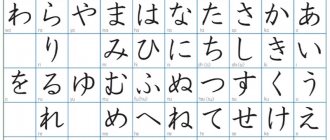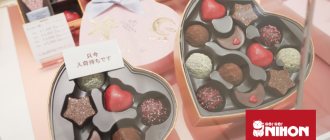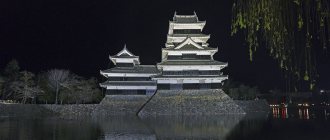What do they call rain in Japan?
Last time we talked to you about snow. But snow is not the only natural phenomenon for which the Japanese have found many names. This time we want to tell you about what kind of rain it gets in Japan and what names it goes by.
Of course, most Japanese people use the universal word雨
ame
when they talk about rain.
However, the story with rain is the same as with snow - depending on the time it falls, the strength and other qualities, the name changes. For example,小雨kosame
,
霧雨kirisame
,
小糠雨konukaame
,
時雨shigure
. All these names only demonstrate how subtly the Japanese felt the slightest changes in natural phenomena, how important it was for them to distinguish between all these types of rain and more.
For convenience, we decided to divide the types of rain into several groups according to the Japanese seasons.
Spring
The most “spring” type of rain in Japan is, of course,桜雨
sakuraame
.
From the name it is immediately obvious that this rain falls during the cherry blossom season. The Japanese believe that sakura under the raindrops has its own special charm. Sometimes this same rain is called花の雨hana no ame
“flower rain.”
, 春時雨
harushigure
, a sudden spring drizzle,
also falls If it coincides with the cherry blossom season, it is called花時雨hanashigure
(flower drizzle).
Tsuyu rainy season
I think that no one will be surprised that this group will contain the largest number of types of rain. It’s not for nothing that this Japanese season is called梅雨
tsuyu,
“plum rain.” All rains that fall at this time have the same name by default.
This season opens with rain, which has more than one name -走り梅雨
hashiri-tsuyu
、
迎え梅雨mukae-tsuyu
、
梅雨の走りtsuyu-no hasiri
. And they all carry approximately the same meaning of “meeting the tsuyu season.” The rainy season opens with rain - everything is logical.
黴雨
bayu
、
五月雨samidare
- these are all other names for
tsuyu
.
Bayu
can even be written with the same characters as
tsuyu
-
梅雨
.
samidare
is also spelled interestingly .
If you are familiar with Japanese writing, you will see the word “may” in the first two characters. Therefore, samidare
can be translated as “May rain.”
However, this is not its only meaning - another one is hidden in its sound.さsa
means the deity-kami of the fields, and
みだれmidare
“dripping water”.
It became May because, according to the old lunar calendar, Samidare
fell on the fifth lunar month.
Samidare
is a lingering rain that falls for a long time.
By the way, if this downpour was interrupted by periods when the sun began to shine, then such sunny intervals were called五月晴れsatsukibare
“clearings during rain.”
It happens that the rainy season passes without heavy rainfall. Then the tsuyu season is called空梅雨
karatsuyu
"empty rainy season",
早梅雨hideritsuyu
"quick rainy season" and
枯れ梅雨karatsuyu
"dry rainy season".
It also happens that it rains
, it would seem, have ended and gone, giving way to the summer heat, but suddenly it begins to pour like buckets again, as if the season had never ended.
Then such rains are referred to as戻り梅雨modoritsu
and
返り梅雨kaeritsu
“returning rainy season,” as well as
残り梅雨nokoritsu
“remaining rainy season.”
Weather in Japanese
The theme of weather is universal in any country and in any society, especially where it changes periodically. In Japan, weather issues are very important due to its location. There is hellish heat, snowstorms, typhoons and tsunamis, drought and the rainy season. When meeting and talking with the Japanese, it is simply necessary to know at least a few expressions related to the weather, and thereby maintain a conversation. Today we present to you a list of words and expressions on the topic “Weather”.
A selection of names for autumn rains in Japanese. Autumn rains in Japanese
A selection of names for autumn rains in Japanese. Autumn rains in Japanese
秋入梅(あきついり) - prolonged rain in autumn, can also refer to a name that expresses the state of the onset of autumn, entering the autumn season (along with this rain).
Quite “early autumn rain”, which is included in the list of autumn rains -御精霊雨. 御精霊雨 (おしょろあめ) – rain that falls from the 13th to the 18th of August in the morning. This is a traditional word in Kyushu, so it took a lot of effort and effort to add this word to the collection *)
秋霖(しゅうりん) – long autumn rains.
一雨一度(ひとあめいちど) - expresses the state of rain, when one occurrence of rain also drops the temperature by 1 degree Celsius
秋湿り (あきじめり) – expresses autumn dampness. Persistent rain, which makes it cold and very humid and damp.
秋時雨(あきしぐれ) -autumn rain. Often refers to the end of the fall season. Thus,晩秋の時雨 (ばんしゅうのしぐれ) - refers to late autumn rain that sometimes comes and sometimes doesn’t.
冷雨(れいう)ー cold rain. Refers to late autumn.
Also cold, freezing rain –凄雨 (せいう)
白驟雨(はくしゅうう) – heavy, heavy autumn rain with large drops (like grains of rice)
霧雨(きりさめ) is a useful word, found in the JLPT vocabulary books. Light rain, drizzle. Particles of moisture in the air, as I heard from Canadian friends. Or, when we say: it’s not entirely clear - it seems like it’s raining, but it doesn’t seem to be.
And alsoなごの小便 (なごのしょうんべん) – also drizzle, 霧雨、 prefectural word静岡(しずおか) .
秋さづい (あきさづい) is a word from Niigata Prefecture: rain that lingers since the grain harvest.
蕭雨 (しょうう) – sad rain that creates a mood of loneliness. Drizzling autumn rain causing sadness and melancholy
黄雀雨 (こうじゃくあめ) - sparrow rain. According to one version, it occurs in the 5th month of the lunar calendar. But according to another version, it falls at the beginning of autumn: the 9th month according to the lunar calendar. Refers to a Chinese legend, according to which during this period fish rise from the sea to land and become sparrows *)
About snow in Japanese. Vocabulary about snow
Today we will talk about snow in Japanese.
Not long ago, I had an interesting conversation about snowflakes with an active member of the community, and this question resulted in a rather interesting publication, in the author’s opinion. Of course, this publication will primarily be about snowflakes..., but it was decided to dig deeper into this “snow”... And this is what happened. Of course, the very first word about snow that we begin to learn is the word –雪(ゆき) , i.e. snow as a natural phenomenon. Also in the list of kanji in the Basic Kanji Book, the concept初雪 (はつゆき, first snow) .
At the same time, the question of snowflakes also arises. How exactly do you say “snowflake in Japanese?” For example, for 4-3 kyuyu we were given the words:雪片(せっぺん) - snowflake and 雪の結晶 (ゆきのけっしょう) 、 of course, everything was written down first in kana. And only when we found ourselves in the pre-advanced group, we were given the above-mentioned words written using kanji (however, yours truly knew the second of the words for a long time, since kanji had a habit of going 1-2 levels ahead). I repeat, both words were given to us as “snowflakes.” However, it happens that snowflakes are referred to in literature or in some courses only as雪の結晶 (ゆきのけっしょう) , while I and my classmates-senpai-kohai used the word雪片(せっぺん) when it came to snowflakes (yes, frankly speaking, this word is used not only by Kohai senpai), I personally became acquainted with this word thanks to my teacher Yatsuda-sense. And yet, they say that there are people who don’t know the second word (雪片(せっぺん)) . Let's figure it out.
In principle, this is the main difference in the use of the word “snowflake” in Japanese. However, this post would not be complete if it were not for the decision to take a step further. 雪庇(せっぴ)” - overhanging snow block caught my eye several times Agree, it is quite interesting to draw an analogy between a “block” and a “small clutch of crystals” of snow.
But the post about snow doesn’t end there either. We need to put in a word about snow phenomena.
Firstly, this is the word of the 2nd kyuyu吹雪(ふぶき) -blizzard (at least in the new 総まとめ you will find this word in the kanji list). Also included in snow phenomena is降雪(こうせつ) – snowfall (derived words are discussed below).
Also very interesting weather phenomena associated with snow:雪の風花 (ゆきのかざばな) - snow developing in a strong wind.
There are different versions regarding the veracity of the statement about 狸の嫁入り, while狐の嫁入りleaves no shadow of doubt. However, from time to time you come across blogs where, ironically, snow during a clear sky is called that way (there is a link above).
And let's return to precipitation again. The following words will probably be helpful:
” The famous name深雪 (みゆき) means the book version of the term “deep snow”
Well, one more word from the second kyuyu (texts):ホワイトアウト- whiteout. A phenomenon where visibility is greatly reduced due to a large amount of snow (but also sand).
雪見(ゆきみ) – admiring the snow
The snow phenomena are probably over now. But this does not apply to meteorology. Next up are two very interesting terms related to the amount of snow that fell:
amount of snow that fell in a certain period of time (for example, 1-6-24 hours) condition and weather conditions : On the news you can hear:こ、。。。むらはxxxせんちのゆきがありまーす) Such and such a layer of snow fell in such and such a village. And such news means積雪量
And bonus word:酸性雪(さんせいせつ) – acid snow
And now from serious meteorological proposals to simple worldly joys. So, the well-known snow festival in Sapporo (and not only) is translated as雪祭り(ゆきまつり) . And the words associated with it:
雪合戦 (ゆきがっせん) - snowball fightかまくら– kamakura, snow house, like an igloo (emphasis on the first syllable)そり– snow statues, snow sculptures雪だるまor雪達磨or雪ダルマ– snowman, and雪礫 (ゆきつぶて) is basically a snowball (in a lump).
Since the post is being written right before the holidays, it’s worth mentioning the word “White Christmas” orホワイト クリスマスクリスマスfrom English White Christmas
And, a little more literary:
積雪 (せきせつ) - snow cover新雪 (しんせつ) - freshly fallen snow
By the way, about landscapes, in the selection about them you can find the following thematic expressions:
A few more cultural phenomena related to snow. All Japanese scholars know a character with a mythical aura - onna , the snow woman. Well, the more dear Snow Maiden turns into
It is also worth remembering about onomatopoeia:
雪やこんこん - is a well-known expression when children rejoice at the falling snow. From a song. However, a word that at first glance looks like an onomatopoeia is actually not one. 雪やこんこん - an expression from a song about snow, where people rejoice at the falling snow. Actually a play on words. 「雪やこんこ」makes sense「雪よ、此処に来い」(=「雪よ、もっと降れ」 (seen from forums. Note:いゆきよここにこい、 or 雪よ、もっと降れ、ゆきよもっとふれ = snowball, fall more) So, we got a kind of onomatopoeia from the word こんこ(こいこい)
Snowflakes keep falling from the sky quiet) .
ちらちらrefers directly to the size of the snowflakes. ちらちら is the falling or swirling of small particles in the air (often refers to snowflakes and small petals)
Snowflakes fell from the sky
Snowflakes, soft, to emphasize their airiness, softness, incl. and when circling in the wind, it is conveyed in shades ofふわりと/ふわっと
soft snowflakes falling from the sky
サクサク– means snow that creaks (crunches) underfoot
遊歩道の雪はサクサク (ゆうほどうのゆきはサクサク) - On the way to walk, the snow crunches underfoot
But the snow falls from the branches of the trees with a sound .
Snow fell noisily in the bamboo thickets.
As you can see from this post, snow is no joke and for a reason. Snow is its own interesting world, especially when it intersects with vocabulary in the Japanese language.
The content is copyrighted, so a link to this content is required. Huge thanks if you link to this post on social networks
If you find an error, please select a piece of text and press Ctrl+Enter.
Source
Snow. Snowflakes. Forms and varieties of snow. Official terms
Snow.
Snowflakes. Forms and varieties of snow. Official Terms Interesting terms were found that relate to snow, snowflakes (their names in Japanese for their shapes), as well as different names for snow shapes.
Terminology related to snow crystals
雪の結晶(ゆきのけっしょう)
More information about snow shapes can be found on this website
And now a few words about the classification of snow, which is given by Wikipedia (by snow quality, its condition and ambient temperatures)
❄Snow classifications❄
~乾雪(かわきゆき) – dry snow (freshly fallen snow)
This includes:灰雪 (はいゆき) “ash snow”. The finest and driest snow that is possible
粉雪 (こなゆき) - snow grains. Larger dry snow compared to 灰雪
玉雪 (たまゆき) - snow-small balls. Dry snowflakes in the form of balls. Even larger than粉雪
綿雪 (わたゆき) snow flakes. Soft snowflakes, like cotton wool. The same one with onomatopoeiaふかふか
~潤雪(ぬれゆき) – wet snow
This includes snow-mochi *)餅雪 (もちゆき) – light and sticky snow (which can be folded into snowballs)
濡雪 (べたゆき) -slightly stickier snow compared to the previous one
水雪 (みずゆき) watery snow
~締雪(しまりゆき) - snow that is densely “packed”, densely fallen to the surface (old snow. The snow surface is characterized by uniform, rounded, well-connected particles)
This includes小締雪(こじまりゆき) – not too densely compressed snow
硬締雪(かたしまりゆき) – densely packed snow
~潤締雪(ぬれしまりゆき) – wet, compacted snow
This includes:潤締雪 (べたしまりゆき) – wet compacted snow水締雪 (みずしまりゆき) – watery compacted snow
~粒雪(ざらめゆき) – grainy snow
小粒雪(こざらめゆき) – fine-grained snow大粒雪(おおざらめゆき) – coarse-grained snow
~凍雪(こおりゆき) – icy snow (frozen snow)
小凍雪 (こごおりゆき) – fine snow with ice
And now about what remains “behind the scenes” in the group’s posts, and about what else can be found on this site
泡雪 or 沫雪 (あわゆき) - snow that is loose and melts easily. Similar to foam
霧雪 (きりゆき) – very, very fine snow, like droplets of fog
小米雪 (こごめゆき) – fine snow, like grains of rice
湿雪 (しめりゆき しっせつ) – very wet snow containing drops of water. In other words, wet snow
花弁雪 (はなびらゆき) - snow in very large flakes, which in size resemble falling petals of flowering trees
That's all with scientific and pseudo-scientific terms (or simply common names) that describe snow and its forms.
If you found the material useful, please share it on Social Networks. Thanks in advance!
When copying this material, a link to the original is required!!
If you find an error, please select a piece of text and press Ctrl+Enter.
Source
Seasonal vocabulary in Japanese
Snow and the smell of tangerines in winter, snowdrops and the sound of dripping in the spring, poplar fluff and school graduation in the summer, harvesting and the wedge of flying cranes in the fall - associations that are firmly entrenched in our consciousness and culture. What do the Japanese associate with the seasons? Today we will talk to you about 季語 (きご, kigo)
.
The word 季語 (きご, kigo) is formed by two characters, the first meaning “season” and the second meaning “word”. The presence of a special term to designate this lexical group already indicates how attentive the Japanese are to the change of seasons.
All four seasons are presented in Japan. We will start with you in the spring.









